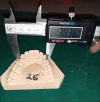Assessment of sexual dimorphism in Maharashtrian young adults using maxillary intercanine, interpremolar, and intermolar widths: A morphometric study
- PMID: 37234294
- PMCID: PMC10207221
- DOI: 10.4103/jomfp.jomfp_275_22
Assessment of sexual dimorphism in Maharashtrian young adults using maxillary intercanine, interpremolar, and intermolar widths: A morphometric study
Abstract
Introduction: Sexual dimorphism practically involves differences in size and appearance of the same species which does not involve the difference in sexual organs. A significant variation also occurs with the tooth size, shape, etc., which plays a critical role in sex determination. Forensic investigations are used in defining the number of missing people whose skeletal remains are unknown. Depending on the available bones and their state, a variety of methods with varying degrees of reliability are available for identifying unknown remains.
Materials and methods: Fifty male and 50 female patients in the age group 20-30 years were randomly selected after taking a detailed history. All maxillary impressions were made with alginate and poured into a dental stone. These casts were measured for intercanine width, interpremolar width, and intermolar width using a digital vernier caliper, and findings were correlated with sexual dimorphism.
Results: Intercanine width between the tips of right and left maxillary canine was measured in males and females at 36.08 ± 2.04 mm (Range: 30.05-41.64 mm) and in females, the mean intercanine width was 34.31 ± 1.75 mm (Range: 28.35-39.01 mm), respectively. Interpremolar width between the distal pits of right and left first premolars was measured in males and females at 38.97 ± 2.10 mm (Range: 33.94-45.21 mm) and in females, the mean interpremolar width was 36.92 ± 1.87 mm (Range: 31.34 mm), respectively. Intermolar width between the central fossae of right and left first molars was measured in males and females at 50.43 ± 2.25 mm (Range: 44.16-56.84 mm) and in females, the mean intermolar width was 47.90 ± 2.06 mm (Range: 42.66-54.63 mm), respectively.
Conclusion: In males, the mean value of the combination of intercanine, interpremolar, and intermolar widths was 125.47 ± 5.61 mm (Range: 108.15-141.86 mm) and in females, it was 119.12 ± 5.05 mm (Range: 103.25-134.36 mm). Mean values of all combinations were larger in males than in females. Thereby, maxillary arch widths contribute to accuracy in determining the gender of the individual.
Keywords: Arch width; intercanine width; intermolar width; interpremolar width; sexual dimorphism.
Copyright: © 2023 Journal of Oral and Maxillofacial Pathology.
Conflict of interest statement
There are no conflicts of interest.
Figures














Similar articles
-
Alveolar and dental arch morphology in Angle Class II division 2 malocclusion: a comparative study.Rom J Morphol Embryol. 2014;55(3 Suppl):1093-7. Rom J Morphol Embryol. 2014. PMID: 25607390
-
Applicability of odontometric dimensions and indices in sexual dimorphism among Nalgonda population.J Forensic Dent Sci. 2017 Sep-Dec;9(3):175. doi: 10.4103/jfo.jfds_42_16. J Forensic Dent Sci. 2017. PMID: 29657496 Free PMC article.
-
Stature Prediction by Comparing Maxillary and Mandibular Intercanine Width and Intermolar Width among Tamil Nadu Population.J Pharm Bioallied Sci. 2022 Jul;14(Suppl 1):S706-S711. doi: 10.4103/jpbs.jpbs_853_21. Epub 2022 Jul 13. J Pharm Bioallied Sci. 2022. PMID: 36110759 Free PMC article.
-
Sex determination using maxillary arch width of pediatric population of Namakkal district, India: A forensic study.J Oral Maxillofac Pathol. 2019 Sep-Dec;23(3):480. doi: 10.4103/jomfp.JOMFP_226_19. J Oral Maxillofac Pathol. 2019. PMID: 31942146 Free PMC article.
-
Estimation of the Intercanine Width, Intermolar Width, Arch Length, and Arch Perimeter and Its Comparison in 12-17-year-old Children of Faridabad.Int J Clin Pediatr Dent. 2021 May-Jun;14(3):369-375. doi: 10.5005/jp-journals-10005-1957. Int J Clin Pediatr Dent. 2021. PMID: 34720509 Free PMC article.
Cited by
-
Initial arch wires used in orthodontic treatment with fixed appliances.Cochrane Database Syst Rev. 2024 Feb 6;2(2):CD007859. doi: 10.1002/14651858.CD007859.pub5. Cochrane Database Syst Rev. 2024. PMID: 38319008 Free PMC article.
References
-
- Frayer DW, Wolpoff MH. Sexual Dimorphism. Annu Rev Anthropol. 1985;14:429–73.
-
- Vodanović M, Demo Ž, Njemirovskij V, Keros J, Brkić H. Odontometrics: A useful method for sex determination in an archaeological skeletal population? J Archaeol Sci. 2007;34:905–13.
-
- Gustafsson A, Lindenfors P. Human size evolution: No evolutionary allometric relationship between male and female stature. J Hum Evol. 2004;47:253–66. - PubMed
-
- Alvesalo L. Sex chromosomes and human growth. Hum Genet. 1997;101:1–5. - PubMed
-
- Keiser-Nielsen S. Bristol: John Wright & Sons Ltd; 1980. Person identification by means of the teeth.
LinkOut - more resources
Full Text Sources
